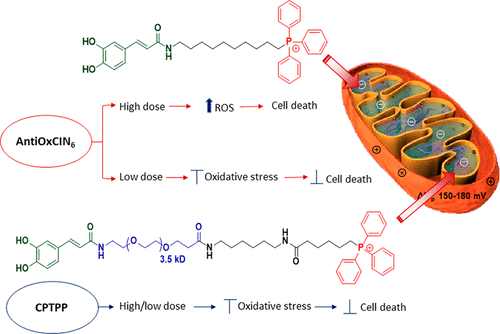当前位置:
X-MOL 学术
›
Bioconjugate Chem.
›
论文详情
Our official English website, www.x-mol.net, welcomes your
feedback! (Note: you will need to create a separate account there.)
Desrisking the Cytotoxicity of a Mitochondriotropic Antioxidant Based on Caffeic Acid by a PEGylated Strategy
Bioconjugate Chemistry ( IF 4.0 ) Pub Date : 2018-07-02 00:00:00 , DOI: 10.1021/acs.bioconjchem.8b00383 Carlos Fernandes 1 , Sofia Benfeito 1 , Ricardo Amorim 1, 2 , José Teixeira 1, 2 , Paulo J. Oliveira 2 , Fernando Remião 3 , Fernanda Borges 1
Bioconjugate Chemistry ( IF 4.0 ) Pub Date : 2018-07-02 00:00:00 , DOI: 10.1021/acs.bioconjchem.8b00383 Carlos Fernandes 1 , Sofia Benfeito 1 , Ricardo Amorim 1, 2 , José Teixeira 1, 2 , Paulo J. Oliveira 2 , Fernando Remião 3 , Fernanda Borges 1
Affiliation

|
Mitochondrial oxidative damage is related to diverse pathologies, including cancer and neurodegenerative diseases. Shielding mitochondria from oxidative damage with mitochondriotropic antioxidants is by now considered an effective therapeutic strategy. Despite the success of the approach, some concerns related with cytotoxicity have been reported. For instance, AntiOxCIN6 is a mitochondriotropic antioxidant based on caffeic acid (CAF) that is cytotoxic in hepatocarcinoma (HepG2) cell lines. PEGylation, often used to enhance drug pharmacologic and pharmaceutical properties, was herein applied to modulate AntiOxCIN6 toxicity drawbacks. So, a dual-functionalization of polyethylene glycol (PEG) with TPP+ and CAF as targeting and antioxidant arms, respectively, was performed by a two-step amidation strategy using ethyl chloroformate and EDC/NHS as coupling reagents. The data showed that the antioxidant properties related with CAF moiety were maintained in the CAF-PEG-TPP conjugate (CPTPP) and that PEGylation process reverted the loss of ability to chelate iron observed with AntiOxCIN6.. In cellular studies, CPTPP was nontoxic to human HepG2 and neuronal (SH-SY5Y) cells, while both CAF and AntiOxCIN6 demonstrated harmful effects in the same cell lines. The lack of cytotoxic events linked to oxidative stress levels observed with CPTPP suggested that PEGylation process somehow modulates the putative toxicity related with the presence of a catechol moiety and/or the TPP+ cation. In addition, the mitochondrial oxygen consumption was not significantly affected by CPTPP treatment in SH-SY5Y cells when compared with nontreated cells. CPTPP showed remarkable antioxidant effects in cell-based assays against several oxidative stress-induced agents (H2O2, t-BHP, and FeNTA). From the data it can be concluded that PEGylation technology can modulate the toxicity of mitochondriotropic antioxidants without disturbing the antioxidant profile of the core antioxidant. PEGylation can be considered a relevant tool to hasten the difficulties related to the design and development of mitochondrial nontoxic and operative drug candidates.
中文翻译:

通过聚乙二醇化策略描述基于咖啡酸的线粒体抗氧化剂的细胞毒性
线粒体的氧化损伤与多种病理学有关,包括癌症和神经退行性疾病。线粒体抗氧化剂可以保护线粒体免受氧化损伤,目前被认为是一种有效的治疗策略。尽管该方法成功,但仍报道了一些与细胞毒性有关的问题。例如,AntiOxCIN 6是基于咖啡酸(CAF)的线粒体抗氧化剂,在肝癌(HepG2)细胞系中具有细胞毒性。常用于增强药物药理和药物特性的聚乙二醇化在本文中用于调节AntiOxCIN 6的毒性缺陷。因此,具有TPP +的聚乙二醇(PEG)双重功能化分别使用氯甲酸乙酯和EDC / NHS作为偶联剂,通过两步酰胺化策略进行了CAF和CAF的靶向和抗氧化。数据表明,在CAF-PEG-TPP共轭物(CPTPP)中保持了与CAF部分相关的抗氧化剂特性,并且PEG化过程使AntiOxCIN 6所观察到的螯合铁的能力丧失得以恢复。在细胞研究中,CPTPP对人类HepG2和神经元(SH-SY5Y)细胞无毒,而CAF和AntiOxCIN 6均在同一细胞系中表现出有害作用。缺乏与CPTPP观察到的与氧化应激水平相关的细胞毒性事件,表明PEG化过程以某种方式调节了与邻苯二酚部分和/或TPP +的存在有关的推定毒性。阳离子。此外,与未处理的细胞相比,SHPT-SY5Y细胞中的CPTPP处理对线粒体耗氧量没有显着影响。CPTPP在针对几种氧化应激诱导剂(H 2 O 2,t- BHP和FeNTA)的基于细胞的测定中显示出显着的抗氧化作用。从数据可以得出结论,聚乙二醇化技术可以调节线粒体抗氧化剂的毒性,而不会干扰核心抗氧化剂的抗氧化剂特性。聚乙二醇化可以被认为是加快与线粒体无毒和有效候选药物的设计和开发有关的困难的相关工具。
更新日期:2018-07-02
中文翻译:

通过聚乙二醇化策略描述基于咖啡酸的线粒体抗氧化剂的细胞毒性
线粒体的氧化损伤与多种病理学有关,包括癌症和神经退行性疾病。线粒体抗氧化剂可以保护线粒体免受氧化损伤,目前被认为是一种有效的治疗策略。尽管该方法成功,但仍报道了一些与细胞毒性有关的问题。例如,AntiOxCIN 6是基于咖啡酸(CAF)的线粒体抗氧化剂,在肝癌(HepG2)细胞系中具有细胞毒性。常用于增强药物药理和药物特性的聚乙二醇化在本文中用于调节AntiOxCIN 6的毒性缺陷。因此,具有TPP +的聚乙二醇(PEG)双重功能化分别使用氯甲酸乙酯和EDC / NHS作为偶联剂,通过两步酰胺化策略进行了CAF和CAF的靶向和抗氧化。数据表明,在CAF-PEG-TPP共轭物(CPTPP)中保持了与CAF部分相关的抗氧化剂特性,并且PEG化过程使AntiOxCIN 6所观察到的螯合铁的能力丧失得以恢复。在细胞研究中,CPTPP对人类HepG2和神经元(SH-SY5Y)细胞无毒,而CAF和AntiOxCIN 6均在同一细胞系中表现出有害作用。缺乏与CPTPP观察到的与氧化应激水平相关的细胞毒性事件,表明PEG化过程以某种方式调节了与邻苯二酚部分和/或TPP +的存在有关的推定毒性。阳离子。此外,与未处理的细胞相比,SHPT-SY5Y细胞中的CPTPP处理对线粒体耗氧量没有显着影响。CPTPP在针对几种氧化应激诱导剂(H 2 O 2,t- BHP和FeNTA)的基于细胞的测定中显示出显着的抗氧化作用。从数据可以得出结论,聚乙二醇化技术可以调节线粒体抗氧化剂的毒性,而不会干扰核心抗氧化剂的抗氧化剂特性。聚乙二醇化可以被认为是加快与线粒体无毒和有效候选药物的设计和开发有关的困难的相关工具。











































 京公网安备 11010802027423号
京公网安备 11010802027423号